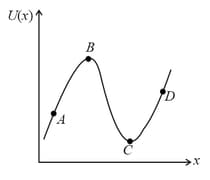MEDIUM
Earn 100
Is frictional force a conservative force or a non-conservative force? Why is it called so?
Important Questions on Work, Power and Energy
MEDIUM
EASY
EASY
MEDIUM
MEDIUM
EASY
EASY

MEDIUM
F = ax + bx2 where a and b are constants. The work done in stretching the unstretched rubber-band by L is :
HARD
MEDIUM
The graphs below show the magnitude of the force on a particle as it moves along the positive -axis from the origin to . The force is parallel to the -axis and conservative. The maximum magnitude has the same value for all graphs. Rank the situations according to the change in the potential energy associated with the force, least (or most negative) to greatest (or most positive).

EASY
EASY
EASY
MEDIUM
| Column-I | Column-II | ||
| (a) | (i) | ||
| (b) | (ii) | ||
| (c) | (iii) | ||
| (d) | (iv) | ||
MEDIUM

MEDIUM
EASY
EASY
MEDIUM
MEDIUM

